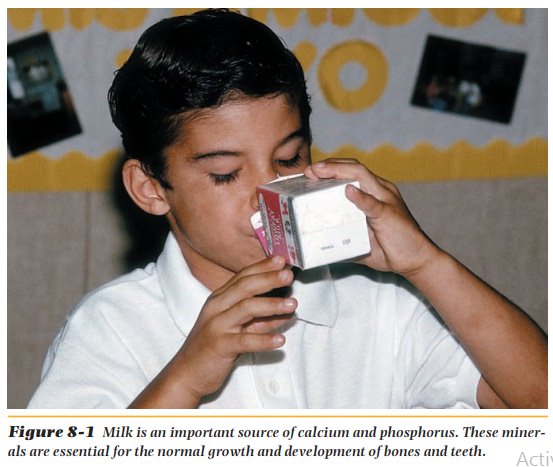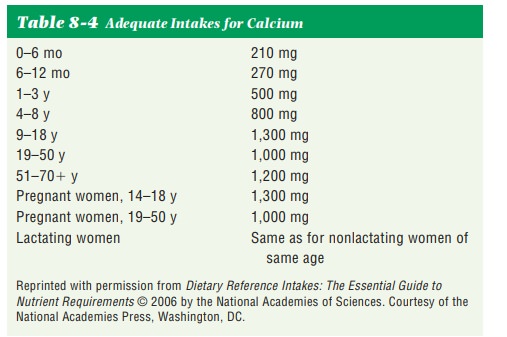Chapter: Nutrition and Diet Therapy: Minerals
Calcium (Ca) - Nutrition Minerals
Calcium (Ca)
The
human body contains more calcium than any other mineral. The body of a
154-pound person contains approximately 4 pounds of calcium. Ninety-ninepercent
of that calcium is found in the skeleton and teeth. The remaining 1% is found
in the blood.
Functions.Calcium, in combination
with phosphorus, is a component ofbones and teeth, giving them strength and
hardness. Bones, in turn, provide storage for calcium. Calcium is needed for
normal nerve and muscle action, blood clotting, heart function, and cell
metabolism.
Regulation of Blood Calcium.Each
cell requires calcium. It is car-ried throughout the body by the blood, and its
delivery to the cells is regulated by the hormonal system. Normal blood calcium
levels are maintained even if intake is poor.
When
blood calcium levels are low, the parathyroid glands release a hor-mone that
tells the kidneys to retrieve calcium before it is excreted. In addition, this
hormone, working with calcitriol (the active hormone form of vitamin D), causes
increased release of calcium from the bones by stimulating the activity of the
osteoclasts (cells that break down bones). Both of these actions increase blood
calcium levels. If calcium intake is low for a period of years, the amount
withdrawn from the bones will cause them to become increasingly fragile.
Osteoporosis may result.
If
the blood calcium level is high, osteoblasts (cells that make bones) will
increase bone mass. During growth, osteoblasts will make more bone mass than
will be broken down. Bone mass is acquired until one is approximately 30 years
old. With adequate consumption of calcium, phosphorus, and vitamin D, bone mass
will remain stable in women until menopause. After menopause, bones will begin
to weaken owing to the lack of the hormone estrogen. A special X-ray, a DEXA
scan, can be taken to determine bone density. If a person is at risk for injury
due to decreased bone density, the phy-sician will decide the best course of
action. Drugs that help prevent further loss of bone mass are available.
Sources.The best sources of
calcium are milk and milk products. Theyprovide large quantities of calcium in
small servings. For example, 1 cup of milk provides 300 mg of calcium (Figure
8-1). One ounce of cheddar cheese provides 250 mg of calcium.

Calcium
is also found in some dark green, leafy vegetables. However, when the vegetable
contains oxalic acid, as spinach and Swiss chard do, the calcium remains
unavailable because the oxalic acid binds it and prevents it from being
absorbed. When the intake of fiber exceeds 35 grams a day, calcium will also
bind with phytates (phosphorus compounds found in some high-fiber cereal),
which also limits its absorption.
Factors
that are believed to enhance the absorption of calcium include adequate vitamin
D, a calcium-to-phosphorus ratio that includes no more phos-phorus than
calcium, and the presence of lactose. A lack of weight-bearing exercise reduces
the amount of calcium absorbed.
Requirements.The estimated requirement for calcium is now
given asan Adequate Intake (AI) level. Calcium is measured in milligrams (mg).
The AIs for calcium at
different ages and conditions are shown in Table 8-4. The recommendations were
made to achieve optimal bone health and to reduce the probability of fractures
in later life.

Calcium supplements
are recommended for persons who are lactose intoler-ant, those who dislike
milk, and those who are unable to consume enough dairy products to meet their
needs. Calcium carbonate, the form found in calcium-based antacid tablets, has
the highest concentration of bioavailable calcium. Calcium supplements appear
to be absorbed most efficiently when consumed in doses of 500 mg.
When purchasing
calcium supplements, check for the USP (United States Pharmacopeia) seal of
approval on the product you select (Figure 8-2). USP-approved products are
unlikely to contain lead or other toxins. Avoid bone meal products because they
may contain lead.

Deficiency.Calcium deficiency may result in rickets. This
is a disease thatoccurs in early childhood and results in poorly formed bone
structure. It causes bowed legs, “pigeon breast,” and enlarged wrists or ankles.
Severe cases can result in stunted growth. Insufficient calcium can also cause
“adult rickets” (osteomalacia), a condition in which bones become soft. And
although the pre-cise etiology of osteoporosis is
not known, it is thought that long-term calcium deficiency is a contributing
factor. Other factors contributing to osteoporosis include deficiency of
vitamin D and certain hormones.
Insufficient calcium
in the blood can cause a condition characterized by involuntary muscle
movement, known as tetany. Excessive intake may
cause constipation, or it may inhibit the absorption of iron and zinc.
Related Topics